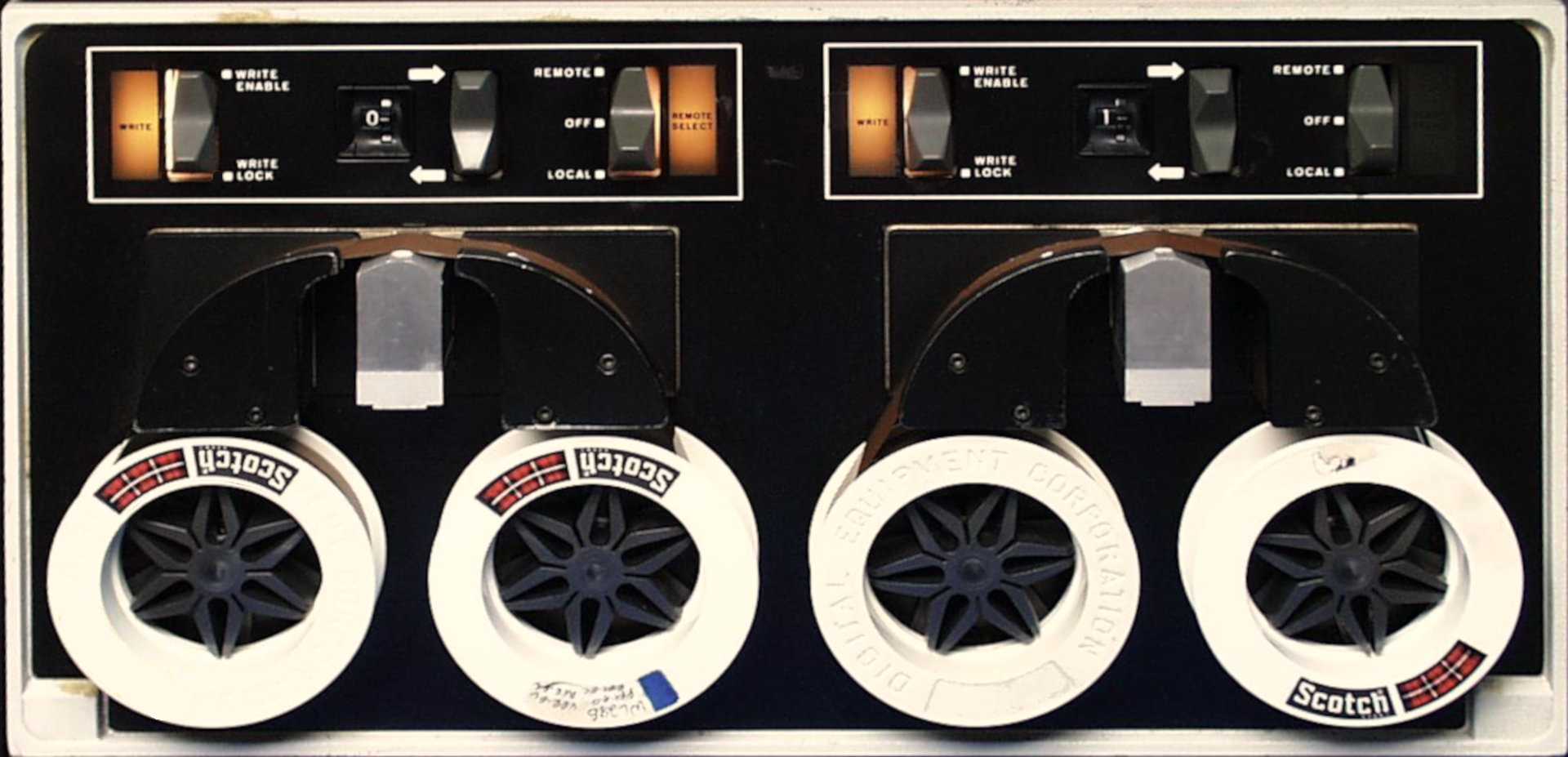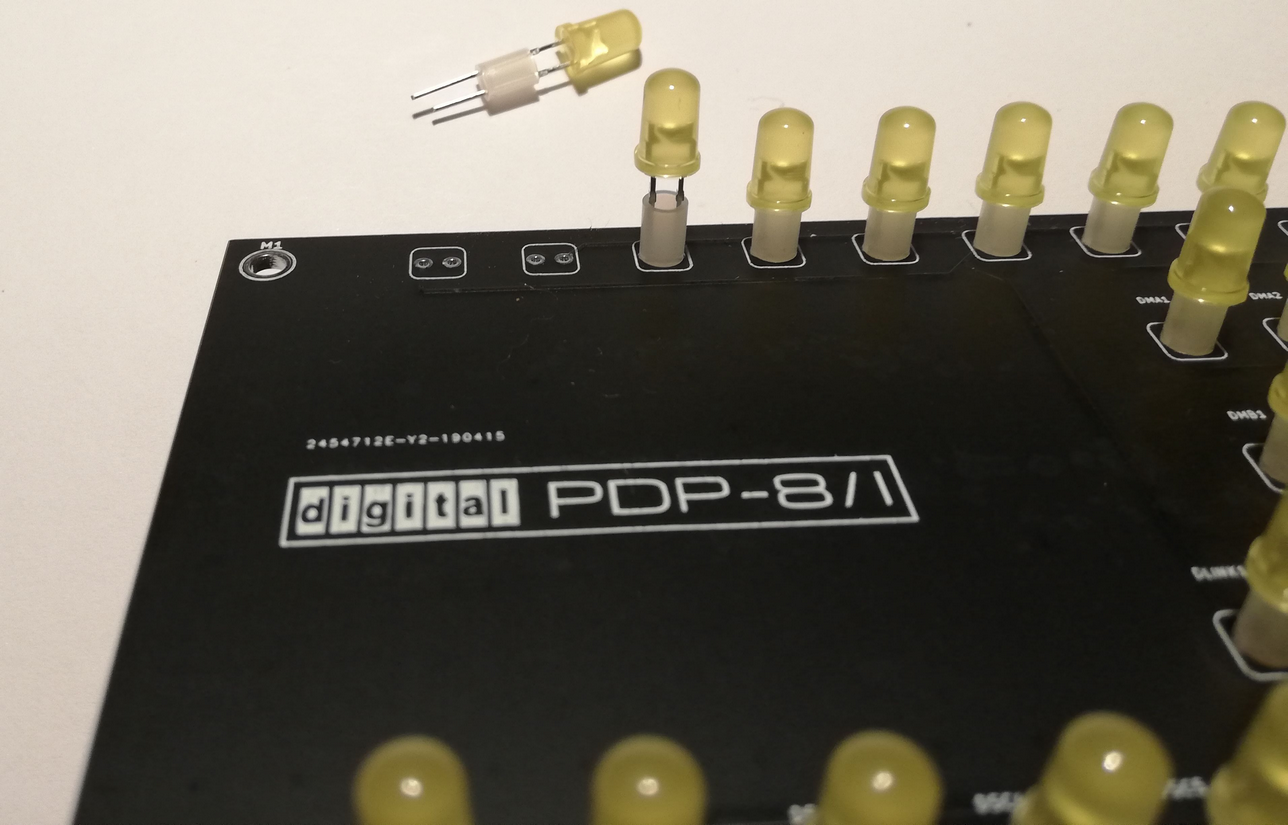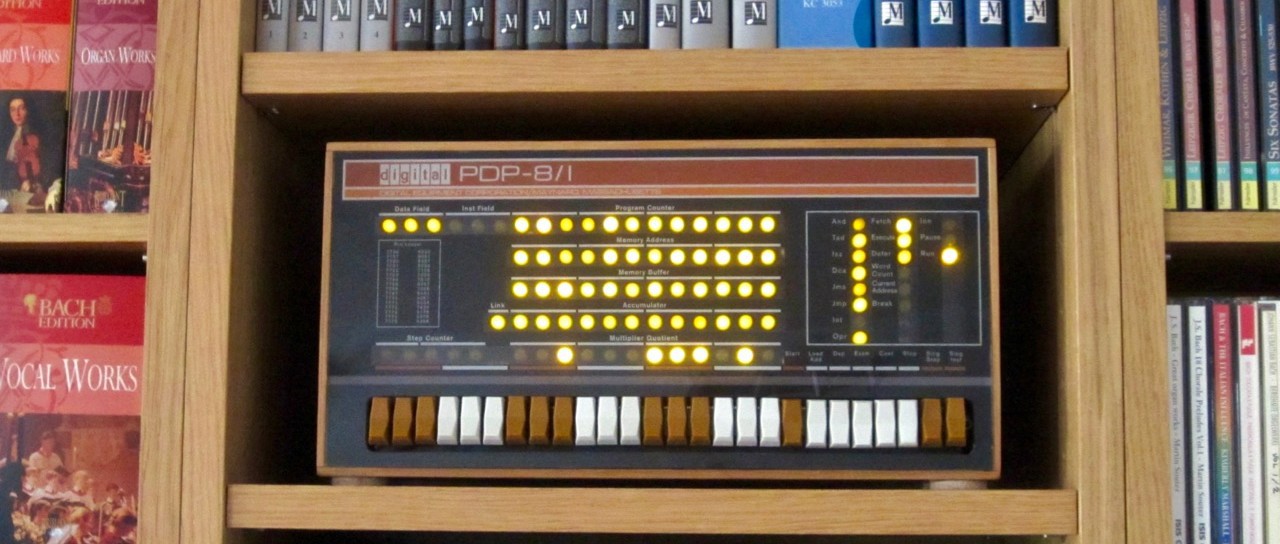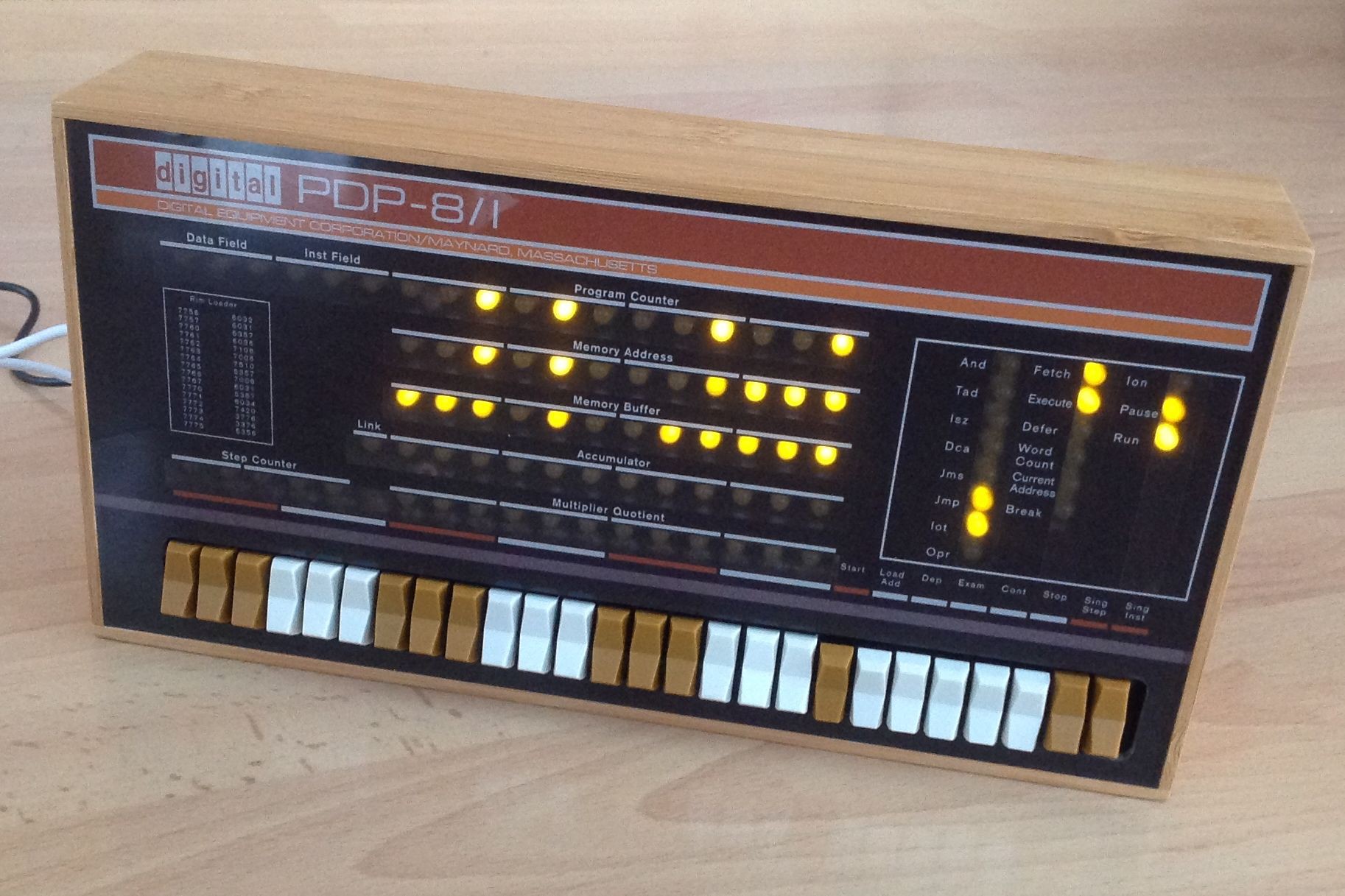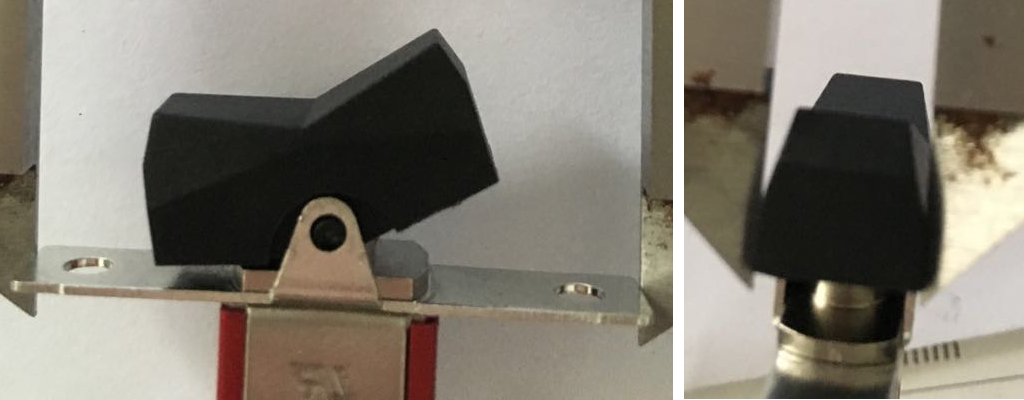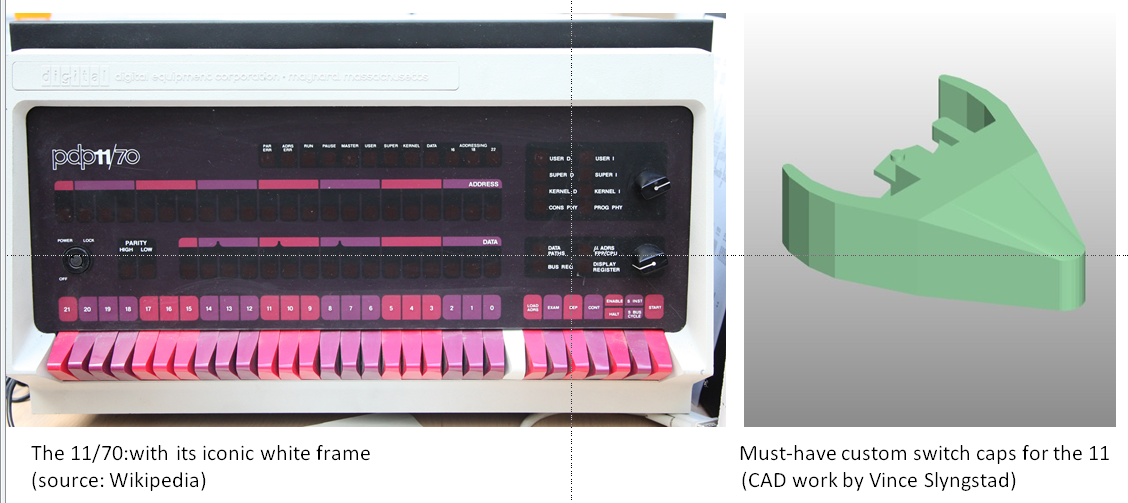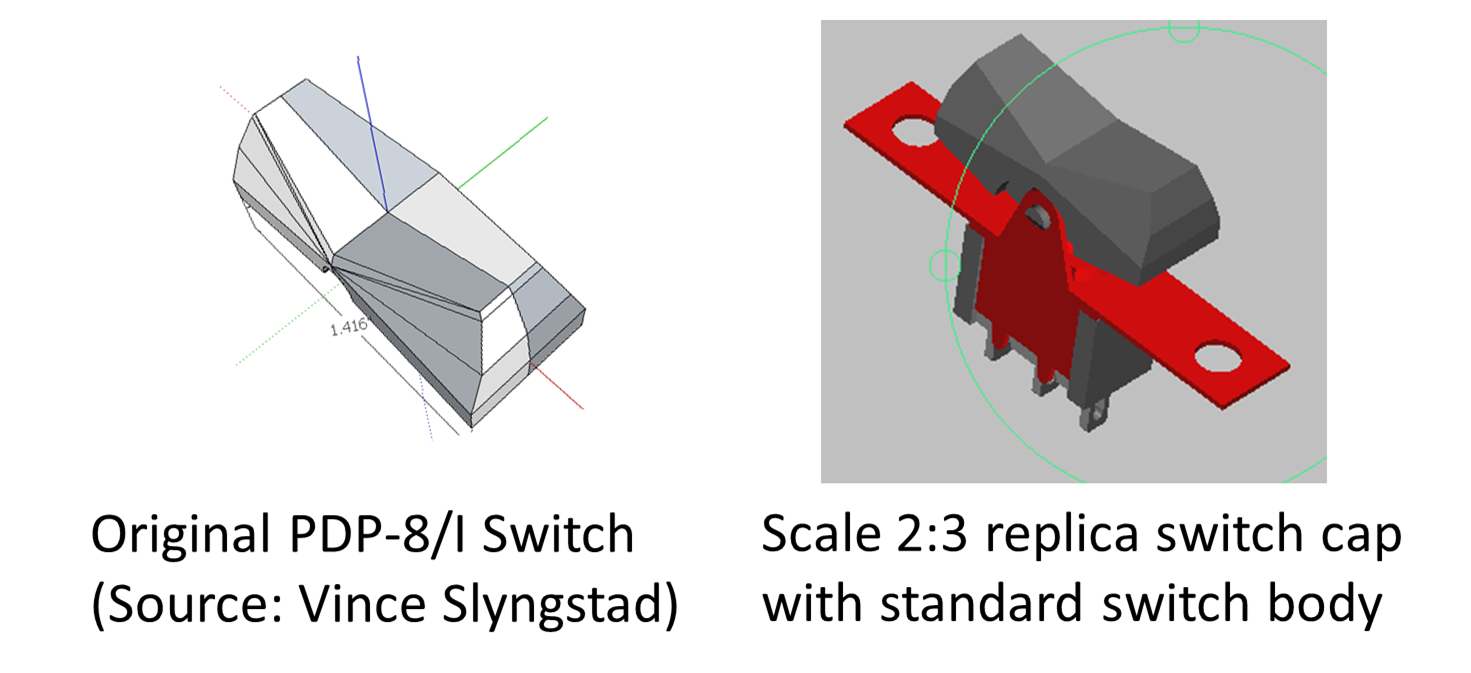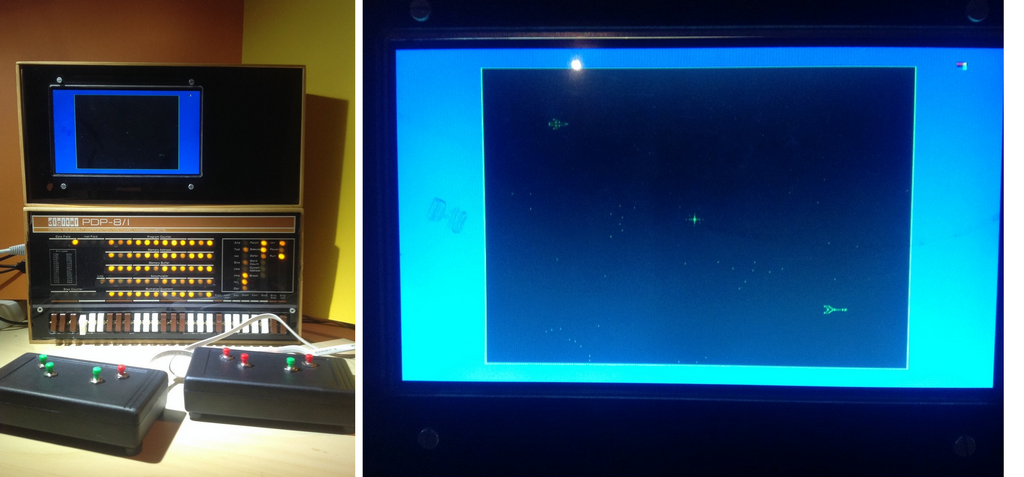-
DECtape on the PiDP-8
12/23/2019 at 01:53 • 1 commentA lot of PDP-8s were run on DECtape - the venerable TU56. Rene Richarz just released his tu56 simulation for the PiDP-8. It's hard to describe - with the TU56 whirring on an animated small HDMI display, you really get a feel for Life Before Disks:
![]()
The simulation is timing-exact, and all controls work just as on the real one. Get one of these cheap small HDMI displays, and you can make a PDP-8 rack with tape drives!
-
A B compiler for the PDP-8...
10/14/2019 at 22:27 • 1 commentNew software for a 50 year old computer doesn't appear every day. A full B compiler should be too much to ask. But despite the minimal hardware, Robert Clausecker managed this feat, and as opposed to C, the simpler B suits the 8 very well.
Details are here (PDF) & here; a video presentation is here: (link).
It's a great introduction to the PDP-8 instruction set, and how to build a compiler for it.
-
The 2019 PiDP-8
09/17/2019 at 15:43 • 0 commentsIt's already out since July, but just to log the improvements:
- There's actually a lot to learn about kit-making: how to prevent beginners from messing up soldering a computer kit for the first time. So it was time for a revamp of the PiDP-8, putting in all those lessons. Easy to mount replica switches; a LED cover panel to quickly put in some 89 LEDs; but the PCB redesign actually took in most of the lessons-learned: when you don't know who is going to solder up your boards, better make wide traces, spaced far apart. Kits will be built with 450C soldering irons used by plumbers. And ensure you can diagnose problems over email. So. Bold statement... Anyone can build this kit now ;)
![]()
- The software got an update to run on the new Pi 4, although that's gross overkill if all you want is a PDP-8. The Pi Zero makes more sense. But most PiDP-8s serve other purposes in the background - file/web/media server and whatnot. Then, the Pi 4 is very nice. And it finally has the graphics oomph to run a picture-perfect CRT simulator for that glorious Serial Terminal feeling.
- The fancy vector graphics (spacewar, but also a 2019 fast-vector Game of Life) are now in and provide a nice fancy demo mode for all that 1960s 12-bit-power.
Nothing has changed in the looks of the PiDP-8 once it's completed. No need to get the hardware update if you already have one! But thank you for all the lessons I learned.
Now the race is on to kit #3000. Or, secret ambition, to one day reach kit #3841, because that's when there are finally more PiDP-8/I's than PDP-8/I's.
-
Major Software Update
05/12/2017 at 23:36 • 0 commentsWell, it's been a year since the last PiDP-8 update. A new software version, in a proper repository, has been set up by Warren. Many thanks not only for that effort, but also for extending the software quite a bit, including Ian's fab lamp emulator. Lamp emulator? Yes. The PiDP has LEDs but the real PDP-8/I had lamps. Lamps glow, but LEDs flicker. If you want, now the PiDP has glowing LEDs.
The repository is here: PiDP-8 repository
Download the latest ready-to-run SD card image here: SD boot image
Any feedback is welcomed at the PiDP forum: PiDP-8 forum
Thanks Warren, and all others who have contributed!
-
Finally - boot time down to 10 seconds
03/04/2016 at 23:46 • 0 commentsThe Raspberry Pi is a great microcontroller - except for the fact that it boots up like a PC, taking 40 seconds. Which is not how a microcontroller should feel. Two months ago, I discovered pipaOS - a pretty standard Raspbian, but it boots up in less than 10 seconds including wifi connectivity. So the latest version of the PiDP 'firmware' is based on this brilliant little distribution.
On another note, in February I made the 3rd batch of PiDP kits, bringing the total in existence to about 700 now. Yay! Confirms again: in the age of the internet, there's no niche obscure enough not to bother with...
The new design with custom switches has worked very well:
![]()
Thanks to Adrian for providing the picture
I will do one more batch of kits in April (hopefully), and then the backlog of kit orders is done. Finally! On to the PiDP-11.
-
New switches, new PiDP-8
01/19/2016 at 23:26 • 3 commentsWell, it took about 4 months but I finally got myself custom switches for the PiDP... It turns out that making custom switches is not all that hard - all I did was make a Sketchup model (adapt an existing model, really) and the switch manufacturer did the rest reasonably painlessly.
Here is the end result: the 2016 PiDP-8...
As usual, I took the pictures in bad lighting so the color looks a bit off from what they really are. So now I know custom switches are not hard to arrange. If anyone is thinking of doing the same, I'm happy to share the details.
Another improvement is in the software. The Raspberry Pi is a nice board but the standard Linux distribution is bloated - taking up to 40 seconds to boot. Which is annoying if you want to use it as a microcontroller. I found pipaOS - which boots into wifi in less than 10 seconds, so that's what the new firmware for the PiDP is build upon. Details are here.
-
New Replica 8/I Switches
10/30/2015 at 11:01 • 1 commentIt seems my first 3D CAD adventure turns out OK. Here's a snapshot of a sample PDP-8/I replica switch straight out of the factory. The production versions will of course not be in black, but the shape is what I had hoped for. It'll still be a month before I have them ready for the kits, but - it's progress!
![]()
-
Next steps…
09/29/2015 at 14:03 • 0 commentsNow I’ve gained some experience with CAD for the PiDP’s new switches, I’d like to explore the manufacturing aspects of ‘Kit Making’ a bit more. For a more ambitious PDP-11 replica - the other machine I always wanted but never had. The PDP-11/70 in particular had a very special form factor:
![]()
You really want those cosmetics for a replica as well: the sculpted white frame, the peculiar switches. Over the last two weeks, two people offered to share the financial risk of making an injection-molded case. One being a right proper Venture Capitalist (although this is a hobby sponsorship for him too – thanks!), who also set up a meeting with the team of one of his companies, people who have proper expertise in the field of injection molding.
Funny how one thing leads to another. If I look back over the past few months, it's amazing how much knowledge-sharing and help was available. People who offered to send someone to China to help source parts, people who beta-tested, supplied original parts to replicate… And how that really can lead to getting you into things you had no clue about just a few months ago!
Although the PiDP-8 project will only be completed when the new switches are in, it’s drawing to a close. On to the next & bigger thing :)
-
Actual Production - Lessons learned the hard way
09/09/2015 at 13:47 • 0 commentsThe next batch of 250 kits is coming up. Just while I was enjoying VCF MidWest, I got bad news: the manufacturer mailed to say that actually, my switches had not been/would never be shipped. Their production molds were broken. OK... but I had just ordered 250 PCBs and front panels, which depend on the exact measurements of this particular switch. Ouch.
Lesson 1: use standard parts. This one was non-standard, used by the Chinese military 10 years ago. Or something. You only find out afterwards...
Lesson 2: if you buy cheap, get the parts in your hand before planning further.
After three weeks of solution-seeking, things are looking up with the surprisingly helpful switch manufacturer! I will have to ditch the PCBs I made, but a new standard switch with custom-made switch caps is in sight. Custom-made... I learned some about that as well, because I had a go at a custom 3D design for the replacement switches:
![]()
Lesson 3: Making a 3D design of something simple like a switch cap, then have it implemented on the other side of the world is not trivial. Not cheap either. And if you're a hobbyist, you quickly learn of the pitfalls of precision design. 'Nuf said... I have to wait and see how the new switches turn out. Manufacturing time is a month.
Oh well. I can still do a run of kits in October, and then I'll have to take six weeks to respin and test a new PCB. At least I now have switches with standard footprints.
-
spacewar - the first video game - at VCF Midwest
08/21/2015 at 00:32 • 0 commentsGot to show something new at VCF Midwest on August 29-30, so here is the PiDP-8 running spacewar, the world's first ever video game.
![]()
See halfway on my page here for spacewar history. Note the homebrew controllers - clunky looks intended (see the originals here). The poor photography not intentional though. It's just very late at night... preparation for a VCF always happens at ungodly hours.
The screen is a $20 HMDI TFT put in a matching case. Makes for a rack-mounted look. I still want to add some instrument features (A/D, D/A converters etc) so it becomes a proper lab peripheral, just like DEC offered back in the day.
Intellectual credits go to Kyle Owen, who ported spacewar to SimH and also made a nice X/Y (oscilloscope) display emulator using Processing. The phosphorous effect deserves a video, really! I ported it to C on the Pi, as Processing has 'issues' with the little machine.
Hope to see you at VCF Midwest next week! Once again, my suitcase will need space on the way back home from VCF MW. So if you're there and want to adopt one of the demo machines, please let me know :)
